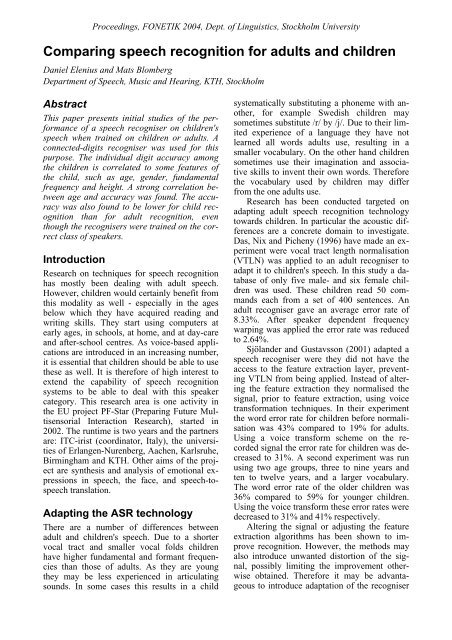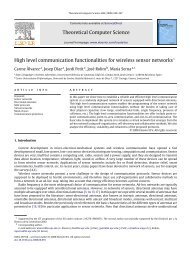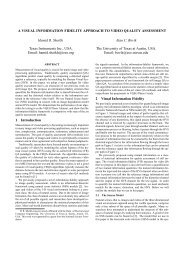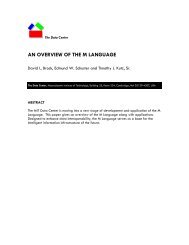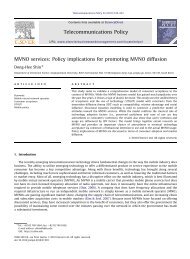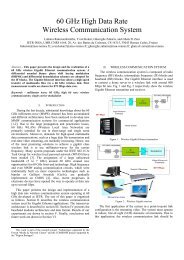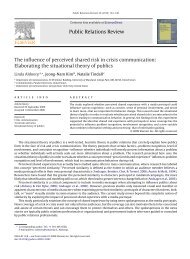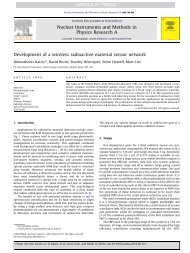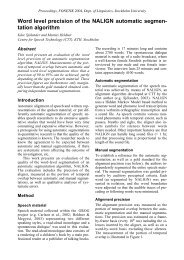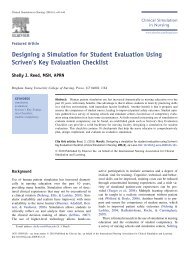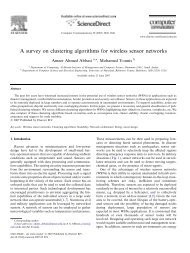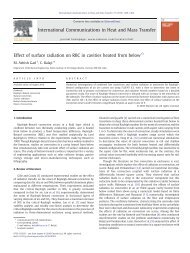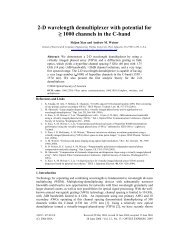Comparing speech recognition for adults and children
Comparing speech recognition for adults and children
Comparing speech recognition for adults and children
You also want an ePaper? Increase the reach of your titles
YUMPU automatically turns print PDFs into web optimized ePapers that Google loves.
Proceedings, FONETIK 2004, Dept. of Linguistics, Stockholm University<br />
<strong>Comparing</strong> <strong>speech</strong> <strong>recognition</strong> <strong>for</strong> <strong>adults</strong> <strong>and</strong> <strong>children</strong><br />
Daniel Elenius <strong>and</strong> Mats Blomberg<br />
Department of Speech, Music <strong>and</strong> Hearing, KTH, Stockholm<br />
Abstract<br />
This paper presents initial studies of the per<strong>for</strong>mance<br />
of a <strong>speech</strong> recogniser on <strong>children</strong>'s<br />
<strong>speech</strong> when trained on <strong>children</strong> or <strong>adults</strong>. A<br />
connected-digits recogniser was used <strong>for</strong> this<br />
purpose. The individual digit accuracy among<br />
the <strong>children</strong> is correlated to some features of<br />
the child, such as age, gender, fundamental<br />
frequency <strong>and</strong> height. A strong correlation between<br />
age <strong>and</strong> accuracy was found. The accuracy<br />
was also found to be lower <strong>for</strong> child <strong>recognition</strong><br />
than <strong>for</strong> adult <strong>recognition</strong>, even<br />
though the recognisers were trained on the correct<br />
class of speakers.<br />
Introduction<br />
Research on techniques <strong>for</strong> <strong>speech</strong> <strong>recognition</strong><br />
has mostly been dealing with adult <strong>speech</strong>.<br />
However, <strong>children</strong> would certainly benefit from<br />
this modality as well - especially in the ages<br />
below which they have acquired reading <strong>and</strong><br />
writing skills. They start using computers at<br />
early ages, in schools, at home, <strong>and</strong> at day-care<br />
<strong>and</strong> after-school centres. As voice-based applications<br />
are introduced in an increasing number,<br />
it is essential that <strong>children</strong> should be able to use<br />
these as well. It is there<strong>for</strong>e of high interest to<br />
extend the capability of <strong>speech</strong> <strong>recognition</strong><br />
systems to be able to deal with this speaker<br />
category. This research area is one activity in<br />
the EU project PF-Star (Preparing Future Multisensorial<br />
Interaction Research), started in<br />
2002. The runtime is two years <strong>and</strong> the partners<br />
are: ITC-irist (coordinator, Italy), the universities<br />
of Erlangen-Nurenberg, Aachen, Karlsruhe,<br />
Birmingham <strong>and</strong> KTH. Other aims of the project<br />
are synthesis <strong>and</strong> analysis of emotional expressions<br />
in <strong>speech</strong>, the face, <strong>and</strong> <strong>speech</strong>-to<strong>speech</strong><br />
translation.<br />
Adapting the ASR technology<br />
There are a number of differences between<br />
adult <strong>and</strong> <strong>children</strong>'s <strong>speech</strong>. Due to a shorter<br />
vocal tract <strong>and</strong> smaller vocal folds <strong>children</strong><br />
have higher fundamental <strong>and</strong> <strong>for</strong>mant frequencies<br />
than those of <strong>adults</strong>. As they are young<br />
they may be less experienced in articulating<br />
sounds. In some cases this results in a child<br />
systematically substituting a phoneme with another,<br />
<strong>for</strong> example Swedish <strong>children</strong> may<br />
sometimes substitute /r/ by /j/. Due to their limited<br />
experience of a language they have not<br />
learned all words <strong>adults</strong> use, resulting in a<br />
smaller vocabulary. On the other h<strong>and</strong> <strong>children</strong><br />
sometimes use their imagination <strong>and</strong> associative<br />
skills to invent their own words. There<strong>for</strong>e<br />
the vocabulary used by <strong>children</strong> may differ<br />
from the one <strong>adults</strong> use.<br />
Research has been conducted targeted on<br />
adapting adult <strong>speech</strong> <strong>recognition</strong> technology<br />
towards <strong>children</strong>. In particular the acoustic differences<br />
are a concrete domain to investigate.<br />
Das, Nix <strong>and</strong> Picheny (1996) have made an experiment<br />
were vocal tract length normalisation<br />
(VTLN) was applied to an adult recogniser to<br />
adapt it to <strong>children</strong>'s <strong>speech</strong>. In this study a database<br />
of only five male- <strong>and</strong> six female <strong>children</strong><br />
was used. These <strong>children</strong> read 50 comm<strong>and</strong>s<br />
each from a set of 400 sentences. An<br />
adult recogniser gave an average error rate of<br />
8.33%. After speaker dependent frequency<br />
warping was applied the error rate was reduced<br />
to 2.64%.<br />
Sjöl<strong>and</strong>er <strong>and</strong> Gustavsson (2001) adapted a<br />
<strong>speech</strong> recogniser were they did not have the<br />
access to the feature extraction layer, preventing<br />
VTLN from being applied. Instead of altering<br />
the feature extraction they normalised the<br />
signal, prior to feature extraction, using voice<br />
trans<strong>for</strong>mation techniques. In their experiment<br />
the word error rate <strong>for</strong> <strong>children</strong> be<strong>for</strong>e normalisation<br />
was 43% compared to 19% <strong>for</strong> <strong>adults</strong>.<br />
Using a voice trans<strong>for</strong>m scheme on the recorded<br />
signal the error rate <strong>for</strong> <strong>children</strong> was decreased<br />
to 31%. A second experiment was run<br />
using two age groups, three to nine years <strong>and</strong><br />
ten to twelve years, <strong>and</strong> a larger vocabulary.<br />
The word error rate of the older <strong>children</strong> was<br />
36% compared to 59% <strong>for</strong> younger <strong>children</strong>.<br />
Using the voice trans<strong>for</strong>m these error rates were<br />
decreased to 31% <strong>and</strong> 41% respectively.<br />
Altering the signal or adjusting the feature<br />
extraction algorithms has been shown to improve<br />
<strong>recognition</strong>. However, the methods may<br />
also introduce unwanted distortion of the signal,<br />
possibly limiting the improvement otherwise<br />
obtained. There<strong>for</strong>e it may be advantageous<br />
to introduce adaptation of the recogniser
Proceedings, FONETIK 2004, Dept. of Linguistics, Stockholm University<br />
to be familiar with the introduced distortion.<br />
Narayanan <strong>and</strong> Potamianos (2003) used a combination<br />
of VTLN <strong>and</strong> linear parameter trans<strong>for</strong>mation<br />
to adapt a recogniser. The parameter<br />
trans<strong>for</strong>m was defined as a common shift of all<br />
mean parameters in the HMM. An optimal frequency<br />
warping <strong>and</strong> shift was estimated using<br />
the maximum likelihood criterion on the observation<br />
likelihood given the HMM. In the experiment<br />
the shift of model parameters was implemented<br />
by shifting the feature-vector <strong>and</strong><br />
keeping the model fixed. In the experiment two<br />
recognisers were used, one trained <strong>for</strong> <strong>adults</strong><br />
<strong>and</strong> one <strong>for</strong> <strong>children</strong>. The speakers used <strong>for</strong><br />
training the <strong>children</strong>'s <strong>speech</strong> recogniser were<br />
from 10 to 17 years. These recognisers were<br />
then evaluated using 6 to 17 year old speakers.<br />
Common <strong>for</strong> all setups was that a rapid improvement<br />
of the per<strong>for</strong>mance was seen from<br />
an age of 7 years up to an age of 13 years. At<br />
the age of 13 the per<strong>for</strong>mance was close to that<br />
of adult <strong>recognition</strong>.<br />
Table 1. Word accuracy of two recognisers, one<br />
trained <strong>for</strong> <strong>adults</strong> <strong>and</strong> one <strong>for</strong> <strong>children</strong> Narayanan<br />
<strong>and</strong> Potamianos (2003).<br />
Set-up Word accuracy Word accuracy<br />
<strong>for</strong> 7 year olds <strong>for</strong> 13 year olds<br />
Recogniser<br />
<strong>for</strong> <strong>adults</strong><br />
62% 95%<br />
Adult recogniser<br />
+ Norm<br />
76% 96%<br />
Recogniser<br />
<strong>for</strong> <strong>children</strong><br />
85% 96%<br />
Child recogniser<br />
+ Norm<br />
89% 97%<br />
Word accuracies of the recognisers are shown<br />
in Table 1. The recogniser dedicated <strong>for</strong> <strong>children</strong><br />
had a higher accuracy on <strong>children</strong>'s <strong>speech</strong><br />
than the adult recogniser. Both recognisers improved<br />
when a combination of VTLN <strong>and</strong> shift<br />
of feature vectors were applied. The method<br />
was more beneficial <strong>for</strong> the adult recogniser<br />
than <strong>for</strong> the child recogniser. Maybe this is because<br />
of a greater difference between the vocal<br />
tract length between <strong>adults</strong> <strong>and</strong> <strong>children</strong> than<br />
between <strong>children</strong>.<br />
Experiment<br />
We have previously reported on the ongoing<br />
recording activity at KTH in the PF-Star project<br />
(Elenius <strong>and</strong> Blomberg, 2003). These recordings<br />
were made with 24 bits at 32 kHz via a<br />
headset microphone <strong>and</strong> an omni-directinal de-<br />
vice st<strong>and</strong>ing on a table in front of the child.<br />
Audio-prompts were read by the recording<br />
leader <strong>and</strong> the prompts were repeated by the<br />
child. This was done in a separate room to suppress<br />
noise produced by the other <strong>children</strong> at<br />
day-care <strong>and</strong> after school centres.<br />
Our first use of this corpus is to compare the<br />
per<strong>for</strong>mance of <strong>speech</strong> <strong>recognition</strong> <strong>for</strong> <strong>adults</strong><br />
<strong>and</strong> <strong>children</strong>. As we are primarily interested in<br />
the implications of the acoustical differences<br />
between <strong>children</strong>'s <strong>and</strong> adult's voices, the fairly<br />
constrained vocabulary <strong>and</strong> grammar of digitstrings<br />
was used. We also believe that this<br />
choice keeps the influence that audioprompting<br />
might have imposed on the <strong>children</strong>'s<br />
natural choice of wording to a minimum.<br />
Adult <strong>speech</strong> was gathered from the Spee-<br />
Con database (Iskra et.al 2002). The recordings<br />
were made via a head-set microphone at 16<br />
kHz. Two sets of 60 speakers, speaking 30 digit<br />
strings each were <strong>for</strong>med. These groups were<br />
used <strong>for</strong> training <strong>and</strong> testing respectively.<br />
Recordings of <strong>children</strong> were taken from our<br />
own database, described earlier. Each child<br />
spoke 30 digit strings. These were recorded<br />
through the same head-set as the adult <strong>speech</strong>.<br />
A training set of 60 <strong>children</strong> was <strong>for</strong>med with<br />
an equal number of <strong>children</strong> of each age group<br />
to avoid emphasising any specific age. The testset<br />
was created with a similar sex distribution<br />
as the training-set. At the time <strong>for</strong> the experiment,<br />
the distribution of recorded <strong>children</strong> was<br />
not evenly distributed regarding age. To make<br />
the set of speakers <strong>for</strong> evaluation as large as<br />
possible, a non-uni<strong>for</strong>m distribution of <strong>children</strong><br />
over age was used. A compensation <strong>for</strong> this was<br />
made by normalising the results according to<br />
age.<br />
The digit-string recogniser was based on<br />
HMMs. Each digit model consisted of two<br />
times as many states as the number of phonemes<br />
in the word. A st<strong>and</strong>ard left-to-right<br />
model was used with the extension of a transition<br />
to skip one state in order to account <strong>for</strong><br />
variation in pronunciation clarity. The system<br />
operated on a <strong>speech</strong> signal sampled at 32 kHz,<br />
a cepstrum frame was produced each 10 ms<br />
using a mel-scaled filterbank <strong>and</strong> a Hamming<br />
window. The unusually high sampling frequency<br />
was chosen because of the higher<br />
b<strong>and</strong>width in <strong>children</strong>'s voices. As the adult<br />
<strong>speech</strong>, stored in the SpeeCon database, was<br />
sampled at 16 kHz the sampling frequency of<br />
this data was converted to 32 kHz sampling<br />
frequency, to fit the recogniser, using linear interpolation.
Proceedings, FONETIK 2004, Dept. of Linguistics, Stockholm University<br />
Results<br />
The recogniser that had been trained on adult<br />
<strong>speech</strong> worked well when tested on adult<br />
<strong>speech</strong>. But the per<strong>for</strong>mance of this recogniser<br />
was substantially lower <strong>for</strong> <strong>children</strong> (Table 2).<br />
Table 2. Word accuracy of two recognisers run on<br />
child <strong>and</strong> adult <strong>speech</strong>.<br />
Accuracy Evaluation set<br />
Training set Adults Children<br />
Adults 97% 51%<br />
Children 61% 87%<br />
The <strong>recognition</strong> <strong>for</strong> <strong>children</strong> improved when the<br />
acoustical model was retrained on <strong>children</strong>'s<br />
<strong>speech</strong>. The per<strong>for</strong>mance was however still<br />
lower than <strong>for</strong> <strong>adults</strong>. To make the picture<br />
completed, this recogniser was tested on adult<br />
<strong>speech</strong> with a low accuracy as a result.<br />
A correlation analysis between the accuracy <strong>and</strong><br />
age, fundamental frequency, first <strong>for</strong>mant, second<br />
<strong>for</strong>mant, height of the child <strong>and</strong> gender was<br />
done. The correlation is sorted in descending<br />
order in Table 3. These features are not independent.<br />
For instance the correlation coefficient<br />
between height <strong>and</strong> F0 was –0.45. The strongest<br />
correlation occurs <strong>for</strong> age. Gender exhibits<br />
quite low correlation.<br />
Table 3. Correlation between some features <strong>and</strong> the<br />
accuracy of the recogniser<br />
Feature Correlation to accuracy<br />
Age 0.48<br />
Average F0 -0.45<br />
Height 0.41<br />
Average F2 -0.21<br />
Gender 0.11<br />
Average F1 -0.07<br />
Recognition of some young <strong>children</strong> works<br />
well, while others were hard to recognise. As<br />
shown in Figure 1, the variance in per<strong>for</strong>mance<br />
is reduced <strong>for</strong> the older <strong>children</strong> compared to<br />
that of younger ones.<br />
Discussion<br />
The per<strong>for</strong>mance level of <strong>children</strong>'s <strong>speech</strong><br />
when using <strong>adults</strong>' models is much too low to<br />
be practically useful. The low accuracy is<br />
probably caused by several factors, the most<br />
important being a shorter vocal tract <strong>and</strong> deviating<br />
pronunciation. Also, some <strong>children</strong> appeared<br />
shy <strong>and</strong> spoke in a very soft, breathy,<br />
voice, possibly because they were uncom<strong>for</strong>table<br />
duo to the recording procedure. It is likely<br />
that the resulting voice quality has lowered their<br />
<strong>recognition</strong> accuracy.<br />
To improve the <strong>recognition</strong> rate, it will be<br />
important to determine the relative influence of<br />
the observed features <strong>and</strong> find compensation<br />
techniques <strong>for</strong> the mismatches. One way to find<br />
the important factors would be to use principal<br />
component analysis.<br />
As was seen, per<strong>for</strong>mance is dependent of<br />
the age of the speaker. We are currently running<br />
experiments were MAP <strong>and</strong> MLLR are used to<br />
create age-dependent models. Preliminary results<br />
indicate a reduction of the error rate by<br />
30%.<br />
In a study by Das, Nix <strong>and</strong> Picheny (1996),<br />
vocal tract length normalization (VTLN) improved<br />
<strong>recognition</strong> of <strong>children</strong> by 6%-units. An<br />
improvement is not surprising since a recognizer<br />
<strong>for</strong> <strong>children</strong> is confronted by a diverse set<br />
of vocal tract sizes in a fairly large range on the<br />
relative scale. We also saw in our study that a<br />
correlation between accuracy <strong>and</strong> the height of<br />
the child <strong>and</strong> F0 existed, indicating sensitivity<br />
against a difference in the size of the vocal<br />
tract. Normalizing <strong>for</strong> this attribute reduces the<br />
variability <strong>and</strong> thereby improves per<strong>for</strong>mance.<br />
Narayan at.al (2002) also combined VTLN with<br />
a simple model trans<strong>for</strong>m resulting in an improvement<br />
of up to 14%-units. As VTLN has<br />
proven useful <strong>for</strong> other languages, we are going<br />
to try it also <strong>for</strong> our recordings of Swedish <strong>children</strong>.<br />
As can be seen in Figure 1, even in the<br />
youngest age group, there are individual <strong>children</strong><br />
that reach perfect <strong>recognition</strong>. Evidently,<br />
this is possible in spite of the expected smaller<br />
physical size of these subjects. It is probable<br />
that these <strong>children</strong> have a pronunciation that<br />
con<strong>for</strong>ms to that of the older <strong>children</strong> <strong>and</strong> that<br />
this overrides the size differences. A possible<br />
method to improve the <strong>recognition</strong> accuracy of<br />
the poorer <strong>children</strong> is to include deviating pronunciation<br />
in the digit models.
Accuracy in %<br />
100<br />
90<br />
80<br />
70<br />
60<br />
50<br />
40<br />
30<br />
20<br />
10<br />
Proceedings, FONETIK 2004, Dept. of Linguistics, Stockholm University<br />
Age vs. per<strong>for</strong>mance<br />
0<br />
3 4 5 6 7 8 9<br />
Age/year<br />
Accuracy Average<br />
Figure 1. Digit accuracy of a connected-digit recogniser<br />
as a function of age. Each data point indicates<br />
the individual accuracy <strong>for</strong> one child.<br />
Conclusion<br />
A digit-string recogniser trained on adult<br />
<strong>speech</strong> per<strong>for</strong>med much worse <strong>for</strong> <strong>children</strong>.<br />
After training the acoustical model on utterances<br />
spoken by <strong>children</strong> a substantial improvement<br />
was found. It was also observed that<br />
the variability in per<strong>for</strong>mance <strong>for</strong> young <strong>children</strong><br />
was larger than <strong>for</strong> older <strong>children</strong>. Further<br />
improvement should be possible by using agedependent<br />
models, age-group adaptation, vocal<br />
tract length normalisation <strong>and</strong> modelling of deviating<br />
pronunciation of young <strong>children</strong>.<br />
Acknowledgement<br />
This work was per<strong>for</strong>med within the PF-Star<br />
project, funded by the European Commission<br />
(IST-2001 37599).<br />
References<br />
Das S., Nix D., Picheny M. (1996): “Improvements<br />
in Children's Speech Recognition<br />
Per<strong>for</strong>mance”. Proceedings of the 1998<br />
IEEE International Conference on Acoustics,<br />
Speech, <strong>and</strong> Signal Processing, Volume:<br />
1 , 12-15 May 1998. pp. 433 – 436.<br />
Elenius K. (2000). Experiences from collecting<br />
two Swedish telephone <strong>speech</strong> databases.<br />
Int. Journal of Speech Technology 3:119-<br />
127.<br />
Elenius, D., Blomberg, M. (2003). Collection<br />
<strong>and</strong> <strong>recognition</strong> of <strong>children</strong>s <strong>speech</strong> in the<br />
PF-Star project. Proc. of Fonetik 2003<br />
Umeå University, Department of Philosophy<br />
<strong>and</strong> Linguistics PHONUM 9, 81-84<br />
Gustafson, J <strong>and</strong> Sjöl<strong>and</strong>er, K (2002): ”Voice<br />
Trans<strong>for</strong>mations For Improving Children's<br />
Speech Recognition In A Publicly Available<br />
Dialogue System”. In the Proceedings<br />
of the International Conference on Spoken<br />
Language Processing 2002, pp 297 - 300.<br />
Iskra, D., Großkopf, B., Marasek, K., v. d.<br />
Heuvel, H., Diehl, F., Kiessling, A. (2002).<br />
SpeeCon - <strong>speech</strong> data <strong>for</strong> consumer devices:<br />
Database specification <strong>and</strong> validation.<br />
Second International Conference on Language<br />
Resources <strong>and</strong> Evaluation 2002.<br />
Narayanan, S <strong>and</strong> Potamianos, A (2002): “Creating<br />
conversational interfaces <strong>for</strong> <strong>children</strong>”.<br />
IEEE Transactions on Speech <strong>and</strong><br />
Audio Processing, Volume: 10, Issue: 2,<br />
Feb. 2002, pp 65 – 78.


